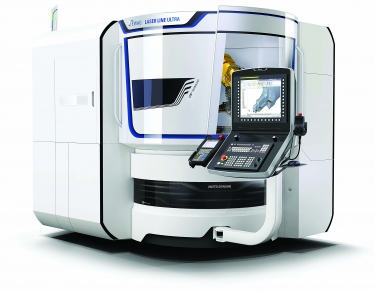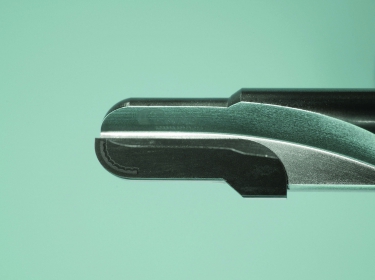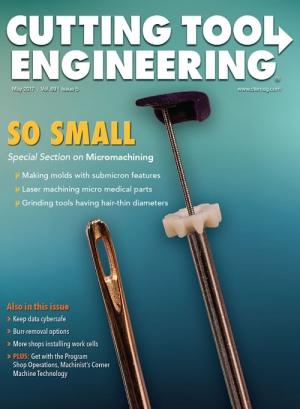A recent report, “Global Ultra Hard Material Cutting Machines Market” by Transparency Market Research, forecasts a healthy compound annual growth rate of 10.8 percent for these machines for the years 2016 to 2024, with the total market reaching $1.8 billion by the end of that period. The report’s authors expect rising demand to lead to more competition and lower prices.
TMR analysts believe this growth will be driven in part by the increased use of synthetic-diamond semiconductor substrates made via chemical vapor deposition. This market is expanding due to the material’s improved thermal management capabilities, allowing greater power densities for electronics within a smaller footprint. CVD-diamond materials also find application in cutting tools, thermal conductors and gemstones.

EWAG’s Laser Line Ultra with ultrashort-pulsed laser technology machines all commercially available cutting materials, including carbide, PCBN, ceramic, PCD, CVD-diamond and monocrystalline diamond without producing heat. Image courtesy of EWAG.
Also pushing the demand for ultrahard-material cutting machines is the rise in use of PCBN as a substitute for diamond, according to the report. Cutting tool tips made of PCBN or PCD are projected to spur demand for machines capable of cutting and shaping these ultrahard materials. PCD is an amalgam of diamond grains sintered in a cobalt/nickel matrix.
The global report analyzes three market segments of cutting machines for ultrahard materials: EDMs, laser cutting machines and others—primarily mechanical grinding machines that remove material with diamond abrasives.
According to Frank Gaebler, director of marketing for laser solutions provider Coherent Inc., Santa Clara, Calif., traditional grinding products used to shape tool tips made of PCD introduce microcracks, which weaken the tools. Grinding also can pull individual diamond grains out of the PCD matrix, leaving voids along the edge of the tip. To minimize these voids, manufacturers have tended to use PCD made with a smaller diamond grain, which has the unfortunate effect of reducing tool life.
EDM has the ability to create precise, complex shapes in ultrahard materials. However, the TMR report points out that new fiber laser technology is 30 times faster than EDM. It also efficiently machines complex geometries with finer-quality surfaces.
There are other benefits, too, according to Gaebler. EDM requires a material that is electrically conductive, such as PCBN, but synthetic-diamond tools are nonconducting. The diamond grains in PCD tools are also nonconducting. As a result, EDMs are unable to create complex shapes, such as chipbreakers and chamfers, in these materials.

This PCD tool was produced on a EWAG machine using a Coherent laser. Image courtesy of EWAG.
Gaebler said both nanosecond fiber lasers in the 532nm (green) wavelength range and picosecond pulsed lasers are being used for cutting ultrahard materials. Ultrafast picosecond lasers provide higher precision and can create more-sophisticated surfaces on these materials than nanosecond lasers.
“When processing PCD, in particular, the problem of creating voids is completely eliminated with the laser,” he said. That is because it is a noncontact process, which has no tendency to pull grains loose from the matrix, enabling the use of larger diamond grains and extending the life of tools.
According to Gaebler, ultrafast-pulsed laser ablation of the tool edge means cutting can be accomplished at a significantly lower temperature than with other processes. This keeps the crystal structure of the man-made diamond from converting to softer graphite and, therefore, yields a stronger cutting edge.
Gaebler believes that ultrafast, industrial-grade picosecond lasers are superior to fiber lasers for cutting these materials. “They give you higher flexibility for materials, higher ablation rates, and the highest process quality and accuracy, compared to nanosecond lasers,” he said.
The TMR report’s projected growth rate of over 10 percent for ultrahard material cutting machines is “pretty realistic,” Gaebler said, adding that the growth for the lasers powering these machines is even higher than that, as the market is ramping up.
“We’ve seen some really good growth in this business—north of 10 percent,” he said.
Contact Details
Related Glossary Terms
- chemical vapor deposition ( CVD)
chemical vapor deposition ( CVD)
High-temperature (1,000° C or higher), atmosphere-controlled process in which a chemical reaction is induced for the purpose of depositing a coating 2µm to 12µm thick on a tool’s surface. See coated tools; PVD, physical vapor deposition.
- electrical-discharge machining ( EDM)
electrical-discharge machining ( EDM)
Process that vaporizes conductive materials by controlled application of pulsed electrical current that flows between a workpiece and electrode (tool) in a dielectric fluid. Permits machining shapes to tight accuracies without the internal stresses conventional machining often generates. Useful in diemaking.
- grinding
grinding
Machining operation in which material is removed from the workpiece by a powered abrasive wheel, stone, belt, paste, sheet, compound, slurry, etc. Takes various forms: surface grinding (creates flat and/or squared surfaces); cylindrical grinding (for external cylindrical and tapered shapes, fillets, undercuts, etc.); centerless grinding; chamfering; thread and form grinding; tool and cutter grinding; offhand grinding; lapping and polishing (grinding with extremely fine grits to create ultrasmooth surfaces); honing; and disc grinding.
- metalcutting ( material cutting)
metalcutting ( material cutting)
Any machining process used to part metal or other material or give a workpiece a new configuration. Conventionally applies to machining operations in which a cutting tool mechanically removes material in the form of chips; applies to any process in which metal or material is removed to create new shapes. See metalforming.
- polycrystalline cubic boron nitride ( PCBN)
polycrystalline cubic boron nitride ( PCBN)
Cutting tool material consisting of polycrystalline cubic boron nitride with a metallic or ceramic binder. PCBN is available either as a tip brazed to a carbide insert carrier or as a solid insert. Primarily used for cutting hardened ferrous alloys.
- polycrystalline diamond ( PCD)
polycrystalline diamond ( PCD)
Cutting tool material consisting of natural or synthetic diamond crystals bonded together under high pressure at elevated temperatures. PCD is available as a tip brazed to a carbide insert carrier. Used for machining nonferrous alloys and nonmetallic materials at high cutting speeds.
- shaping
shaping
Using a shaper primarily to produce flat surfaces in horizontal, vertical or angular planes. It can also include the machining of curved surfaces, helixes, serrations and special work involving odd and irregular shapes. Often used for prototype or short-run manufacturing to eliminate the need for expensive special tooling or processes.


